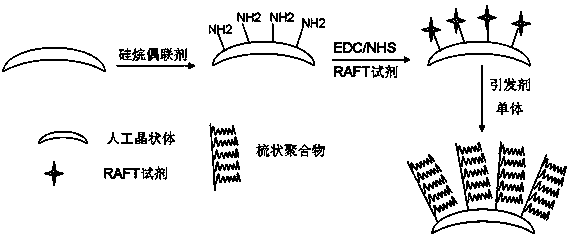A kind of intraocular lens with surface comb polymer hydrophilic modification and preparation method thereof
A technology of intraocular lens and comb-like polymer, applied in the direction of intraocular lens, eye implant, coating, etc., can solve the problems of expensive antibody drugs, affecting application value, toxic and side effects, etc., and achieve good anti-adhesion characteristics , good anti-adhesion properties, high biocompatibility
- Summary
- Abstract
- Description
- Claims
- Application Information
AI Technical Summary
Problems solved by technology
Method used
Image
Examples
Embodiment 1
[0030] Firstly, take a clean intraocular lens, and use amino functional group-containing silane coupling agent surface treatment to bring amino groups on the surface: choose a hard intraocular lens, its material can be polymethyl methacrylate, immerse to 1×10 -5 mol / L γ-aminopropyltriethoxysilane aqueous solution, hydrolyzed for 3 hours, the surface of the intraocular lens material is covered with amino groups, washed with water, and dried with nitrogen gas for later use.
[0031] Next, the RAFT chain transfer agent containing carboxyl functional groups is grafted by chemical methods: after surface amination, it is immersed in the chain transfer agent containing carbodiimide (EDC), N-hydroxysuccinimide (NHS) and carboxyl groups. Thiobenzoates. This example takes 4-cyano-4-(phenylthioformylthio)pentanoic acid (CPCTTP for short) as an example, where EDC: 3mg / mL; NHS: 6mg / mL, CPCTTP: 2mg / mL, at room temperature Stirring was continued for 2 hours, and the RAFT reagent CPCTTP was...
Embodiment 2
[0036] First, take a clean intraocular lens, and make the surface with amino groups through the surface treatment of silane coupling agent containing amino functional groups: choose soft intraocular lens, its material is polyhydroxyethyl methacrylate hydrogel, immerse to 1×10 -5 mol / L γ-aminopropylmethyldiethoxysilane, hydrolyzed for 3 hours, the surface of the intraocular lens material is covered with amino groups, washed with water, and dried with nitrogen gas for later use.
[0037]Next, the RAFT chain transfer agent containing carboxyl functional groups is grafted by chemical methods: after surface amination, it is immersed in the chain transfer agent containing carbodiimide (EDC), N-hydroxysuccinimide (NHS) and carboxyl groups. Thiobenzoates. This example takes 2-(dodecyltrithiocarbonate)-2-methylpropionic acid (DDMAT for short) as an example, where EDC: 3mg / mL; NHS: 6mg / mL, DDMAT: 2mg / mL , kept stirring at room temperature for 2 hours, and the RAFT reagent DDMAT was g...
Embodiment 3
[0042] First, take a clean intraocular lens, and use amino functional group-containing silane coupling agent surface treatment to bring amino groups on the surface: choose a soft intraocular lens, and its material is polydimethylsiloxane PDMS silicone rubber. Immersion to 1×10 -5 mol / L γ-aminopropyltrimethoxysilane aqueous solution, hydrolyzed for 3 hours, the surface of the intraocular lens material is covered with amino groups, washed with water, and dried with nitrogen gas for later use.
[0043] Next, the RAFT chain transfer agent containing carboxyl functional groups is grafted by chemical methods: after surface amination, it is immersed in the chain transfer agent containing carbodiimide (EDC), N-hydroxysuccinimide (NHS) and carboxyl groups. Thiobenzoates. This example takes 2-(dodecyltrithiocarbonate)-2-methylpropionic acid (abbreviated as DTMP) as an example, where EDC: 3mg / mL; NHS: 6mg / mL, DTMP: 2mg / mL , kept stirring at room temperature for 2 hours, and the RAFT a...
PUM
 Login to View More
Login to View More Abstract
Description
Claims
Application Information
 Login to View More
Login to View More - R&D
- Intellectual Property
- Life Sciences
- Materials
- Tech Scout
- Unparalleled Data Quality
- Higher Quality Content
- 60% Fewer Hallucinations
Browse by: Latest US Patents, China's latest patents, Technical Efficacy Thesaurus, Application Domain, Technology Topic, Popular Technical Reports.
© 2025 PatSnap. All rights reserved.Legal|Privacy policy|Modern Slavery Act Transparency Statement|Sitemap|About US| Contact US: help@patsnap.com



